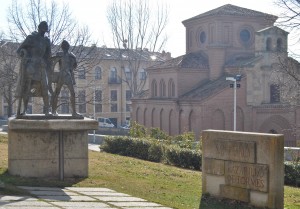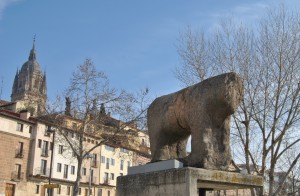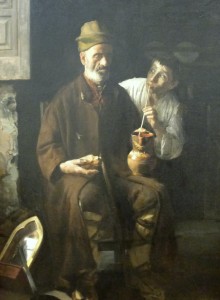El Lazarillo de Tormes Posted by Magda on Jun 17, 2011 in Spanish Culture
“La vida del Lazarillo de Tormes y de sus fortunas y adversidades” es una novela corta pero muy interesante, publicada de forma anónima en 1554, que es considerada la precursora del Quijote de Cervantes. La razón de que el autor no desease ser conocido podría ser el contenido “herético” de esta novela satírica: fue incluida en el “Índice de libros prohibidos” de la Inquisición española. Ha sido más de cuatro siglos después cuando descubrimos el nombre del presunto autor: Diego Hurtado de Mendoza, un hombre renacentista nacido en la Alhambra, cuya vida sería un tema perfecto para algún otro artículo.
El libro está escrito en forma de carta, y narra la vida de Lázaro González Pérez, un chico humilde nacid o en el río Tormes, en Salamanca. Si alguna vez visitáis la ciudad, veréis la estatua del Lazarillo (en referencia a los perros guía) y su amo ciego junto al puente romano, así como el toro de piedra en el cual golpearon la cabeza de Lázaro en una de sus primeras aventuras.
o en el río Tormes, en Salamanca. Si alguna vez visitáis la ciudad, veréis la estatua del Lazarillo (en referencia a los perros guía) y su amo ciego junto al puente romano, así como el toro de piedra en el cual golpearon la cabeza de Lázaro en una de sus primeras aventuras.
Tras el Prólogo, leemos sobre la vida de Lázaro y su aprendizaje con diversos amos. No aparecen nombres en la novela, solo “el ciego”, “el clérigo”, “el escudero”, “el fraile”, “el buldero”, “el capellán”, y “el alguacil”; y las experiencias de Lázaro con cada uno de ellos serán relatadas en un capítulo, o tratado. Nuestro protagonista pasará de ser un niño ingenuo a un superviviente en aquella dura época, obteniendo al fin una “buena” vida gracias a la relación adúltera de su mujer con un arzobispo. Al contrario que en la novela caballeresca, el Lazarillo describe de forma vívida y realista las desgracias de la gente pobre, y la hipocresía y bajos valores de la clase alta. Un buen ejemplo de esto último sería el hecho de que el sustento de Lázaro decrece según la clase social de su amo sube.
Así que si necesitais una buena lectura para este verano que os provoque alguna risa, no olvidéis el “Lazarillo de Tormes”. Y para ayudaros, aquí dejo un enlace a la novela tanto en español como en inglés: http://www.4olin.com/indice.html
¡Estaré esperando vuestras opiniones!
“The Life of Lazarillo de Tormes and of His Fortunes and Adversities” is a short but very interesting novel, published anonymously in 1554, which is considered the precursor of Cervantes “Don Quixote”. The reason why the author didn’t want to be known could be the “heretic” content of this satiric novel: it was included in the”Index of Forbidden Books” by the Spanish Inquisition. It was over four centuries later that we found out the name of the alleged writer: Diego Hurtado de Mendoza, a renaissance man born in the Alhambra, whose life would be a perfect topic for another post.
The book is written in the form of a letter, and it talks about the life of Lazaro Gonzalez Perez, a humble boy who was born in the river Tormes, in Salamanca. If you ever visit the town you will see a statue of both the Lazarillo (as a reference to guide dogs) and his blind master next to the Roman bridge, as well as the stone bull where Lazaro’s head was knocked in one his first adventures.
After the Prologue, we read about Lazaro’s life and his apprenticeship with several masters.  There are no names in the novel, just “the blind man,”, the priest”, “the squire,”, “the friar”, “the pardoner”, “the peddlar”, “the chaplain” and “the constable”; and Lazaro’s experiences with each of them are related in every Chapter or “treatise”. Our protagonist will grow from a naïve child to a survivor in those hard times, getting at the end a “good” life due to his wife’s adulterous relationship with the archbishop. As opposed to chivalry novels, Lazarillo depicts in a vivid and realistic manner the misfortunes of poor people, and the hypocrisy and low values of higher classes. A good example of it is the fact that Lazaro’s nourishment decreases as the social class of his master goes up.
There are no names in the novel, just “the blind man,”, the priest”, “the squire,”, “the friar”, “the pardoner”, “the peddlar”, “the chaplain” and “the constable”; and Lazaro’s experiences with each of them are related in every Chapter or “treatise”. Our protagonist will grow from a naïve child to a survivor in those hard times, getting at the end a “good” life due to his wife’s adulterous relationship with the archbishop. As opposed to chivalry novels, Lazarillo depicts in a vivid and realistic manner the misfortunes of poor people, and the hypocrisy and low values of higher classes. A good example of it is the fact that Lazaro’s nourishment decreases as the social class of his master goes up.
So if you need a good reading for this summer which will provide you with a good laugh, have “Lazarillo de Tormes” in mind. And to help you, here is a link to the novel both in English and Spanish: http://www.4olin.com/indice.html
I’ll be waiting for you to share your opinion!

Build vocabulary, practice pronunciation, and more with Transparent Language Online. Available anytime, anywhere, on any device.





Comments:
Andreas:
¡Hola Magda!
Muchas gracias. La leeré sin falta en cuanto termine de leer Cien años de soledad. Espero que ésta sea más positiva. Para conocer el idioma hay que leer la literatura clásica, pero la mayoria de los libros son muy depresivos.
Andreas
Magda:
Hola Andreas!
¿Estás leyendo Cien años de soledad? Es una de mis novelas favoritas, algo dura si, pero muy buena.
El Lazarillo tiene un fondo muy duro, es muy crítico, pero el tono satírico y de humor en que está escrito hace que no puedas evitar la risa en ocasiones. Si lo lees, espero que lo disfrutes. ¡E intentaré pensar en alguno más alegre para otro post!
Andreas:
¡Hola Magda!
Sí estoy leyéndola. Si no me equivoco, es una alegoría de la vida en América Latina.
Magda:
Si, aunque Macondo es un lugar ficticio, podría ser cualquier ciudad que ha sufrido por políticas dictatoriales y revoluciones diversas a lo largo de los años.
Esta novela es también un gran ejemplo del llamado “realismo mágico”.